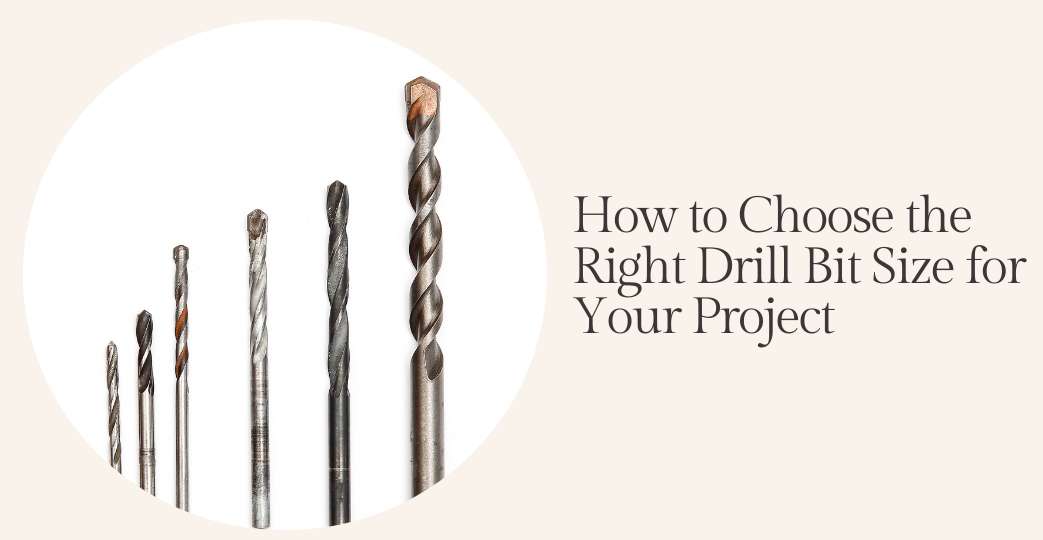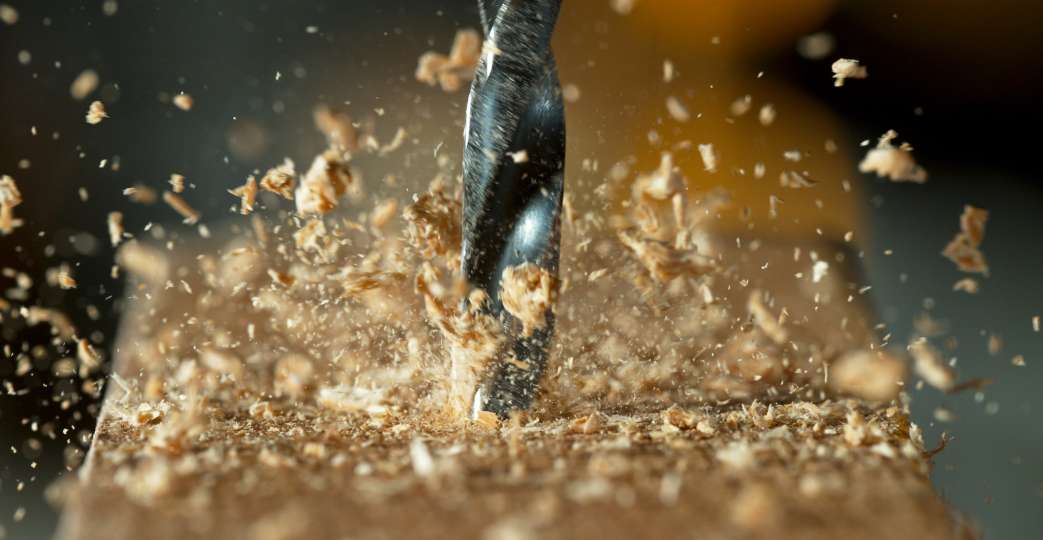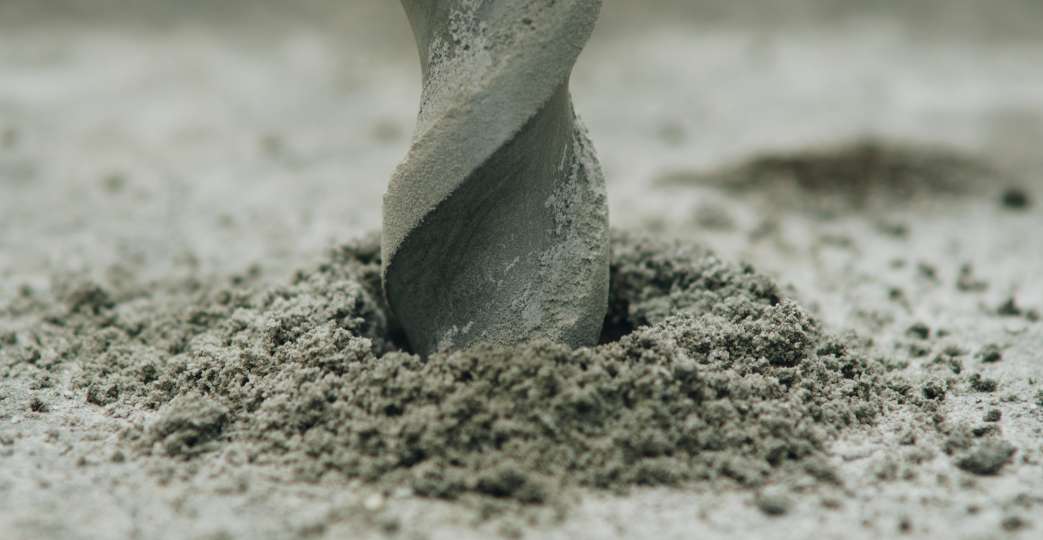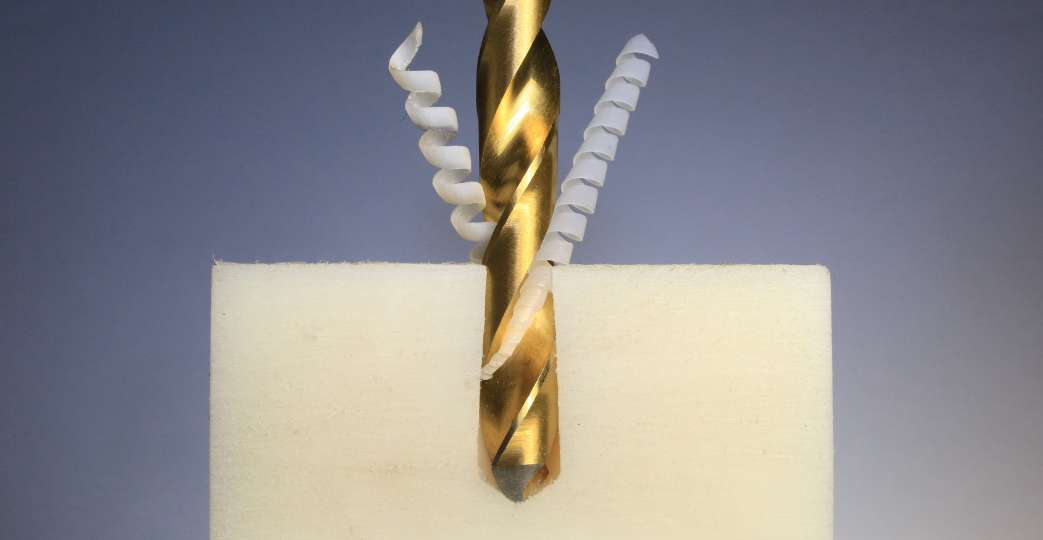How to Choose the Right Drill Bit Size for Your Project?

May 22nd 2025
Drilling a perfect hole is essential in construction across the UAE. Understanding exactly how to choose drill bit size isn't always straightforward, but it's vital for strong fixings, material safety, and avoiding costly mistakes. We know every project demands precision. This guide cuts through the complexity, showing you how to choose the correct drill bit for any material or job. Mastering this skill and having the right tools elevate your work. Let's find the perfect fit.
How to Choose the Right Drill Bit Size: The 4 Key Factors
Choosing the right drill bit size isn't a one-size-fits-all scenario. It depends primarily on four critical factors. Let's explore each in detail.
Factor 1: The Material You Are Drilling Into
Different materials require different bit types and careful consideration of size. Here's a breakdown of common construction materials and how to approach sizing:
I. Drilling into Wood

Wood is versatile but can easily split or splinter using the wrong technique or size.
1. Pilot Holes for Screws
This is the most common type of hole in woodworking. A pilot hole prevents the screw from splitting the wood, especially near edges or in hardwoods. The pilot hole size should generally match the core diameter of the screw – the part of the shank without the threads. This allows the threads to grab firmly into the wood while the body passes through the pre-drilled hole.
Measure the screw's core diameter just below the threads. Use a drill bit that is slightly smaller than this measurement. For hardwoods, choose a size closer to the core diameter. For softwoods, you might go slightly smaller to ensure a good grip.
Many screw boxes provide recommended pilot hole sizes. We often use screw gauge charts as a quick reference on-site. For example, an ordinary #an 8 wood screw might require a 7/64" or 3mm pilot hole in hardwood, but maybe a 5/64" or 2mm in softwood.
2. Clearance Holes
If a screw or bolt needs to pass freely through one piece of wood before threading into another (like joining two boards where only one needs to be threaded), you drill a clearance hole in the first piece. The size should match the full diameter of the screw shank (including threads) or the bolt.
Measure the widest part of the screw/bolt shank. Choose a bit larger than this to allow free passage.
3. Through Holes
Drill a hole through a piece of wood, perhaps for a dowel or pipe. The size is simply the required diameter of the hole.
4. Larger Holes
For larger holes (over 1 inch / 25mm), you typically move away from standard twist bits and use spade bits, Forstner bits, or hole saws. The size is marked directly on these bits.
Key Takeaway
Twist bits are standard for smaller holes. Brad-point bits are excellent for precision, preventing wandering. Spade bits and Forstner bits are for larger, flat-bottomed holes. Auger bits are for deep, clean holes. Hole saws cut large diameter holes.
II. Drilling into Metal
Metal is more rigid and generates more heat when drilled. Size selection depends on the metal type and the hole's purpose.
1. Pilot Holes (Often Not Needed for Small Screws)
For self-tapping metal screws, a pilot hole size is crucial and usually specified by the screw manufacturer. Like wood, it matches the screw's core diameter. For larger bolts or machine screws where you'll tap threads into the metal, the pilot hole size is critical. It corresponds to the tapping drill size, which is smaller than the final thread diameter. Tapping charts are essential here.
2. Clearance Holes
For bolts or screws passing through metal, the size matches the bolt/screw diameter, plus a small allowance for clearance.
3. Through Holes
The size is simply the required diameter of the hole.
4. Starting a Hole
We often start with a smaller pilot bit for drilling into metal, especially larger holes. This creates a starting point, prevents the larger bit from wandering, and makes the process easier on the drill and the bit. The pilot bit size should be slightly wider than the web (the thin section in the centre) of the larger drill bit you plan to use.
Key Takeaway
High-Speed Steel (HSS) twist bits are standard. HSS bits with titanium coating or cobalt alloy are more durable and resistant to heat, which is ideal for harder metals like stainless steel or structural steel commonly used in UAE construction. Black oxide HSS bits are suitable for general-purpose metal drilling.
III. Drilling into Masonry and Concrete

Concrete and masonry (bricks, blocks, stone) require percussion drilling and specialised bits. The size is almost always dictated by the fastener you intend to use.
1. Anchor Holes
Whether you are installing plastic rawl plugs, metal expansion anchors, chemical anchors, or through bolts, the manufacturer always specifies the required drill bit diameter. You must use the exact size recommended for the specific anchor.
A hole that is even slightly too large will prevent the anchor from expanding correctly and securing the load. A hole too small means the anchor won't fit, or you'll damage it trying to force it.
Look at the packaging or technical data sheet for your anchor. A 10mm rawl plug requires a 10mm masonry bit. A 12mm sleeve anchor requires a 12mm masonry bit. There is little room for variation here.
2. Through Holes
Sometimes, you need to drill through a wall for pipes or conduits. Size is the required diameter of the passage. Again, masonry bits are needed.
Key Takeaway
Masonry bits have carbide tips brazed onto a steel shank. They are designed to withstand the impact action of a hammer drill or rotary hammer. SDS-Plus and SDS-Max shanks are standard for rotary hammers, offering better power transfer and easier bit changes. Standard straight shanks are used in hammer drills.
IV. Drilling into Tiles and Glass
These brittle materials require special bits and careful, often slower, drilling without hammer action.
1. Fixture Holes
For mounting bathroom fixtures, mirrors, or shelving onto tiled walls, the drill bit size depends on the fastener (screw/anchor) you will use after getting through the tile. You drill through the tile first, then often switch to a masonry bit of the appropriate size to drill into the substrate (blockwork, concrete).
Decide the final anchor size based on the load and wall type. Then, use a tile/glass bit of a size just large enough to allow the masonry bit (or sometimes the anchor itself) to pass through the tile layer cleanly.
2. Through Holes
For pipes or electrical conduits passing through tiles. The size is the required diameter.
Key Takeaway
Spear-point carbide bits, diamond-tipped bits, or special tile bits are used. Diamond core bits are excellent for clean, larger holes in porcelain or stone tiles.
V. Drilling into Plastic

Plastics vary widely in hardness. Soft plastics can grab a bit, while hard plastics can crack.
1. Fixture/Mounting Holes
Size depends on whether you need a pilot hole for a self-tapping screw (size matches core diameter) or a clearance hole for a bolt (size matches bolt diameter + clearance).
2. Through Holes
The size is the required diameter.
For softer plastics, sometimes standard wood or metal bits work, but specialist plastic bits with a modified point can prevent grabbing and melting. For hard plastics like PVC pipe, standard HSS metal bits are often effective. The size is simply the required hole diameter.
Key Takeaway
Standard HSS bits often work, but specialist plastic bits or even wood bits can be used, depending on the plastic type. You can find a variety of HSS bits on FEPY that are suitable for different plastic applications.
Factor 2: The Type of Hole You Need
The function of the hole dictates how you think about its size relative to the fastener.
1. Pilot Holes
As discussed, primarily for screws in wood or metal where the threads need to bite. Size relates to the fastener's core diameter.
2. Clearance Holes
These are for fasteners that need to pass freely through one material layer before engaging in another. Size relates to the fastener's full diameter.
3. Through Holes
Simple holes are designed to pass through a material for wires, pipes, dowels, etc. Size is the required diameter.
4. Blind Holes
Holes are drilled to a specific depth but not all the way through. The size is the required diameter, but controlling the depth requires a drill stop or careful measurement. This is common for anchor points in walls or creating precise joints in woodworking.
5. Counterbore/Countersink Holes
These are holes where the head of a screw or bolt needs to sit flush with or below the surface. You drill a standard clearance or pilot hole first, then use a counterbore or countersink bit (or a combination bit) to create the recess for the head.
The size of the pilot/clearance hole is determined as above. The counterbore/countersink size matches the head diameter and angle of the fastener.
Factor 3: The Fastener or Fixture You Are Using
This is where the rubber meets the road for pilot and anchor holes.
1. Screws
For wood screws, self-tapping metal screws, or drywall screws, you need a pilot hole size for the screw's core diameter to prevent splitting and ensure a strong connection.
2. Bolts
For through bolts where you use a nut and washer, you drill a clearance hole size slightly larger than the bolt's diameter.
3. Anchors (Wall Plugs, Sleeve Anchors, Chemical Anchors)
As highlighted earlier, the drill bit size must exactly match the anchor's specified diameter. There is no room for estimation here. An 8mm anchor requires an 8mm bit. A 16mm chemical anchor requires a 16mm bit. Always check the anchor packaging.
Factor 4: The Drill You Are Using
While the project dictates the ideal bit size, your drill needs to be capable of driving that bit through the material effectively and safely.
1. Chuck Capacity
Drill chucks have a maximum capacity (e.g., 10mm, 13mm). You cannot use a drill bit with a shank larger than your chuck can hold. Even if the cutting diameter is within capacity, the shank size is the limiting factor for standard twist bits. Larger bits like spade bits or hole saws have shanks designed to fit standard chuck sizes.
2. Power and Torque
Attempting to drive a significant diameter bit through a dense material (like concrete or thick steel) requires considerable power and torque. An underpowered drill will struggle, potentially stall, overheat, or cause excessive vibration.
3. Hammer Action (for Masonry/Concrete)
Masonry and concrete require a drill with a hammer function. A standard drill will barely scratch the surface. You need either a hammer drill (for smaller tasks, impacting within the chuck) or, ideally, a rotary hammer (for heavier work, delivering piston-driven impact).
The size of the bit you can comfortably use is directly related to the power of the hammer mechanism. A small hammer drill might handle up to a 10mm masonry bit effectively. In comparison, a mighty rotary hammer can easily handle 20mm or larger SDS bits. This is where your choice of power tool becomes critical, and it brings us to the fact that having the right drill is just as important as selecting the perfect drill bit size.
How to Choose the Right Drill Bit Size Products?

You've identified the material, the hole type, the fastener, and the ideal drill bit size and type. Now, you need a drill that can handle it. At FEPY, we pride ourselves on offering a comprehensive range of power drills from the world's leading brands, trusted by professionals in the UAE for their reliability and performance.
Let's consider some examples from our extensive inventory and how they pair with different drilling tasks and bit sizes:
For General Purpose Drilling (Wood, Metal, Light Masonry with appropriate bits)
You need a versatile drill driver or a combi drill. These are workhorses for everyday tasks.
- For drilling pilot holes in wood, clearance holes in metal, or driving medium-sized screws, models like the Bosch GSR 18V-50 C/L Solo 18V Cordless Drill Driver or the Bosch GSB 18V-50 Combi Drill (which adds a hammer function for occasional masonry) are excellent choices. They offer balanced power, good battery life, and robust construction suitable for site work.
- Similarly, the DeWalt DCD777S2 provides reliable performance for a wide range of drilling and driving applications up to moderate bit sizes. For lighter duty or tighter spaces, a compact model like the Stanley SCH20S2K-B5 cordless drill provides convenience for smaller bit sizes.
Key Takeaway
When you've chosen your standard twist bits or wood bits up to, say, 10-13mm, these drills are your go-to.
For Heavy-Duty General Use and More Serious Masonry
When you encounter tougher materials or need more power for larger diameter standard bits, you step up in capability.
- The Dewalt D2560K-B5 is a top-tier combi drill with significant control and a high-performance hammer function that can tackle more demanding masonry applications than standard combi drills, allowing you to use larger masonry bits (check manufacturer specs for recommended max size).
Key Takeaway
Pair this drill with your larger HSS bits for metal or robust masonry bits when a full rotary hammer isn't necessary but is more than a standard combi drill.
For Dedicated Masonry and Concrete Drilling (The Heavy Hitters)
If you are drilling anchor holes repeatedly in concrete or intricate masonry, you need a dedicated rotary hammer. These machines use a piston mechanism to generate powerful impacts independently of rotation, specifically designed to pulverise concrete.
- Models like the DCH133M1EXP-GB or Dewalts D25133KW (cordless SDS-Plus rotary hammers) offer incredible freedom of movement on site with serious concrete drilling power, allowing you to efficiently use SDS-Plus bits in sizes required for standard anchors (8mm, 10mm, 12mm, etc.).
- Corded rotary hammers like the Bosch GBH 2-28F or Makita HR2470 are legendary on job sites for their consistent power and durability, perfect for prolonged concrete drilling tasks with SDS-Plus bits.
- For smaller masonry jobs or where corded power is readily available, corded hammer drills like the Stanley SDH700, Makita HR2661, or Makita HR2631FT provide the necessary hammer action for masonry bits, often up to 13mm or 16mm, complementing the standard drilling function found in models like the Stanley SDH700 corded drill.
Key Takeaway
These are the drills you reach for when your project demands specific masonry bit sizes for anchors or through holes in concrete.
How to Choose the Right Drill Bit Size: Your Quick Reference Chart
Selecting the correct drill bit size is fundamental to successful drilling. Use this chart as a quick guide on the job site to determine the appropriate bit type and size for common applications.
| Material | Goal / Hole Type | Fastener / Fixture | Bit Type Examples | How to Determine Bit Size | Key Action / Consideration | Matching Drill Type (General) |
| Wood | Pilot Hole (Screws) | Wood/Drywall/Self-tapping Screw | HSS, Brad Point, Twist | Match Screw Core Diameter. Use the chart/test. | Prevents splitting. Softer wood: smaller bit. Harder wood: a bit closer to the core. | Drill Driver, Combi (Rotary) |
| Clearance Hole (Pass-thru) | Screw, Bolt | HSS, Twist | Match Screw/Bolt Full Diameter + small clearance. | Fastener passes freely through this piece. | Drill Driver, Combi (Rotary) | |
| Through Hole | Dowel, Pipe, Wire, etc. | Twist, Spade, Auger, Hole Saw | Match Outside Diameter of item. | Choose bit type by hole quality/size. | Drill Driver, Combi (Power varies) | |
| Anchor Hole (into Wood) | Light-duty Anchor | HSS, Twist | EXACTLY Match Anchor Diameter. | Ensure correct depth. | Drill Driver, Combi (Rotary) | |
| Metal | Pilot Hole (Screws) | Self-tapping Metal Screw | HSS, HSS-Ti/Co | Match Screw Core Diameter. Consult screw specs. | Use slow speed, lubrication. Clear swarf. | Drill Driver, Combi (Rotary) |
| Pilot Hole (Tapping) | Bolt (for metal threading) | HSS, HSS-Ti/Co | Match Tapping Drill Size for thread. Use a tapping chart. | Critical size for thread quality. Slow speed, lubrication. | Drill Driver, Combi (Rotary) | |
| Clearance Hole (Pass-thru) | Bolt, Machine Screw | HSS, HSS-Ti/Co | Match Bolt/Screw Full Diameter + clearance. | Use the pilot bit first for larger holes. Lubrication essential. | Drill Driver, Combi (Power varies) | |
| Through Hole | Pipe, Conduit, etc. | HSS, HSS-Ti/Co, Metal Hole Saw | Match Outside Diameter of item. | Use pilot bit for large holes. Lubrication. Clear swarf. | Drill Driver, Combi (Power varies) | |
| Masonry / Concrete | Anchor Hole | RawlPlug, Sleeve Anchor, etc. | Masonry Bit, SDS-Plus/Max | EXACTLY Match Anchor Diameter. Consult anchor packaging. | MUST use Hammer Action. Crucial for anchor strength/safety. | Hammer Drill or Rotary Hammer |
| Through Hole | Pipe, Conduit, etc. | Masonry Bit, SDS-Plus/Max, Core Drill | Match Outside Diameter of item. | MUST use Hammer Action. Clear dust. Core drill for large holes. | Hammer Drill or Rotary Hammer | |
| Tile / Glass | Hole (through tile layer) | Anchor (into substrate) | Tile/Glass Bit (Spear, Diamond) | Size to allow the Masonry Bit/Anchor to pass through tile. | NO Hammer Action. Slow speed. Use water for cooling/chip prevention. | Drill Driver (Rotary ONLY). THEN switch to Hammer Drill/Rotary Hammer for the wall. |
| Through Hole | Pipe, Conduit, etc. | Tile/Glass Bit (Spear, Diamond Core) | Match Outside Diameter of item. | NO Hammer Action. Slow speed. Water cooling is often essential. | Drill Driver (Rotary ONLY) | |
| Plastic | Pilot Hole (Screws) | Self-tapping Screw | HSS, Plastic Bit | Match Screw Core Diameter. | Slow speed for soft plastic (prevents melting). | Drill Driver, Combi (Rotary) |
| Clearance Hole (Pass-thru) | Bolt, Screw | HSS | Match Bolt/Screw Full Diameter + clearance. | Speed depends on plastic hardness. | Drill Driver, Combi (Rotary) | |
| Through Hole | Pipe, Fittings, etc. | HSS | Match Outside Diameter of item. | Speed depends on plastic hardness. | Drill Driver, Combi (Rotary) |
Frequently Asked Questions (FAQs)
Q. What size pilot hole do I need for a specific screw?
The ideal pilot hole size depends on the screw gauge (diameter) and the material hardness. For wood screws, it generally matches the screw's core diameter (excluding threads). Hardwood requires a pilot hole closer to the core size than softwood to prevent splitting. Always check screw packaging recommendations or use a pilot hole size chart for standard screw gauges. Scrap test is highly recommended.
Q. My drill bit size chart gives imperial sizes, but my bits are metric. How do I convert?
You can use online conversion calculators or a conversion chart. Common conversions to remember: 1 inch = 25.4 mm. 1/8" is approx. 3.2mm, 1/4" is approx. 6.4mm, 1/2" is approx. 12.7mm. Often, you can find metric bits that are very close equivalents (e.g., 3mm for 1/8", 6mm for approx. 1/4", 12mm for approx. 1/2").
Q. Can I use a wood drill bit on metal or vice versa?
Generally, no. Wood bits are designed to clear chips quickly and may have points that grab in metal. Metal bits (HSS) will eventually drill wood but leave a rougher hole and can cause burning. Masonry bits should only be used with hammer action on masonry. Using the wrong bit type for the material damages the bit and produces poor results.
Q. What if my anchor hole is slightly too big?
A hole that is too large for an expansion anchor (like a rawl plug or sleeve anchor) will prevent the anchor from expanding correctly against the sides of the hole. This results in a weak, unreliable fixing that can pull out under load, creating a significant safety risk. Always use the exact size specified by the anchor manufacturer.
Q. How do I drill a large diameter hole (e.g., 50mm) in wood?
For holes larger than about 25mm, you typically use specialist bits like spade bits (for rougher holes), Forstner bits (for clean, flat-bottomed holes), or hole saws (for large diameter through holes). The size is marked directly on the bit. Ensure your drill has enough power and a chuck capacity (shank size) that is compatible with the bit.
Q. My drill bit is getting very hot. What does that mean?
Excessive heat indicates friction. This can happen if you are using the wrong bit type for the material, drilling at too high a speed, not clearing swarf (especially in metal), or not using lubrication when drilling metal. It dulls the bit quickly and can damage the material or the bit itself. Adjust your technique and speed, and consider lubrication or a different bit type.
Q. Does the type of drill bit shank matter for size?
Yes, in terms of compatibility with your drill's chuck. A standard straight shank fits into most drill chucks up to their maximum capacity (e.g., 10mm or 13mm). SDS-Plus and SDS-Max shanks are specific to rotary hammers and allow larger, heavy-duty bits to be used effectively with that type of tool. Ensure the bit's shank matches your drill's receiver.
Final Words
Mastering how to choose drill bit size is a fundamental skill that enhances the quality, speed, and safety of your work. It's a mark of a true professional. And having access to the right drill bits and the proper drills to use them is crucial for putting that knowledge into practice.
FEPY is your leading online destination for construction supplies in the UAE. Our comprehensive selection of power drills, including top models from the top brands like Bosch, Makita, Stanley, and many others listed above, ensures you'll find the perfect tool for any application.
FEPY has a PRO membership option that can unlock multiple exclusive benefits for you, including additional discounts, credit facilities, quicker delivery all across the UAE, priority support and many more.